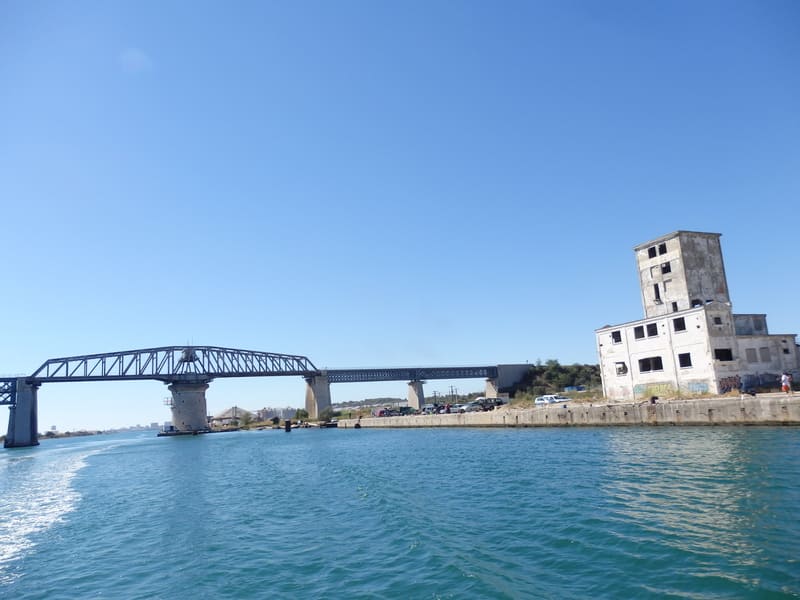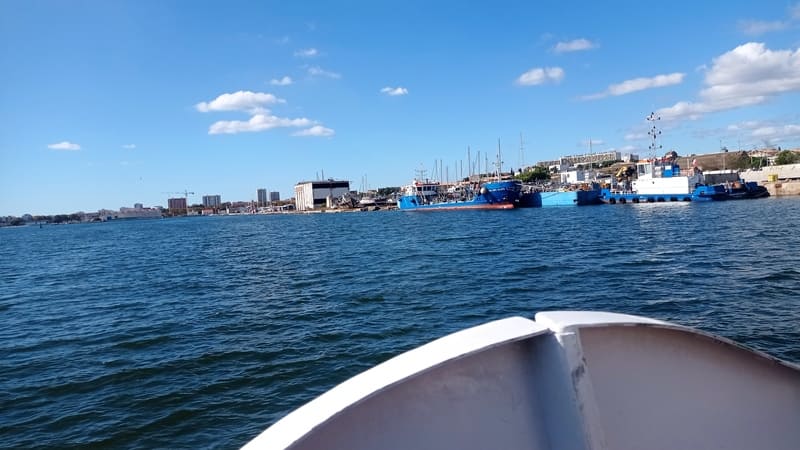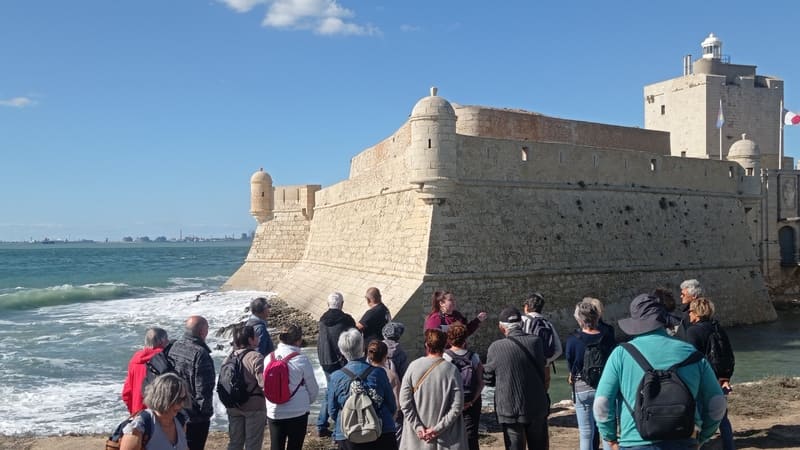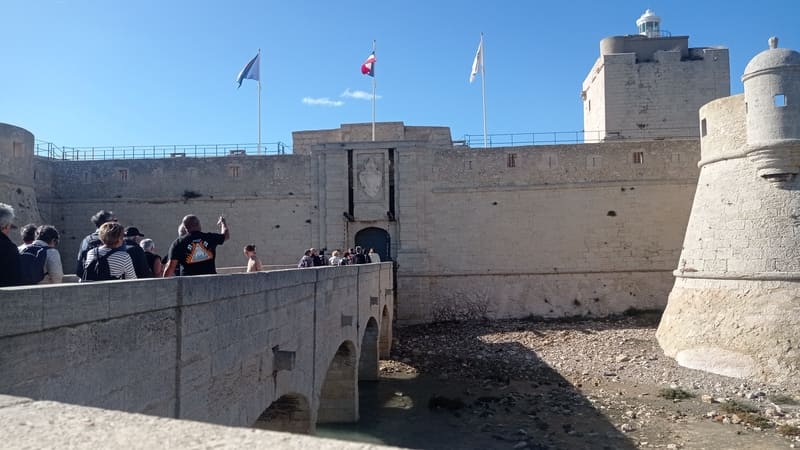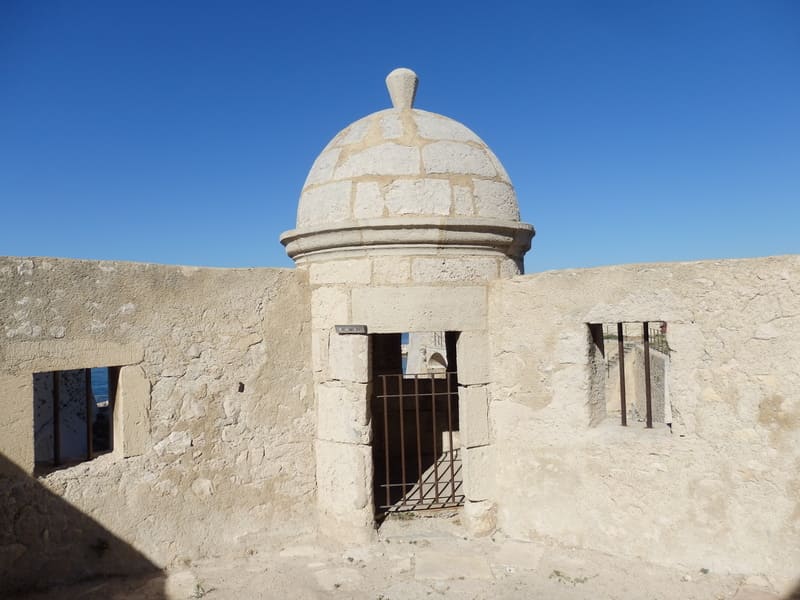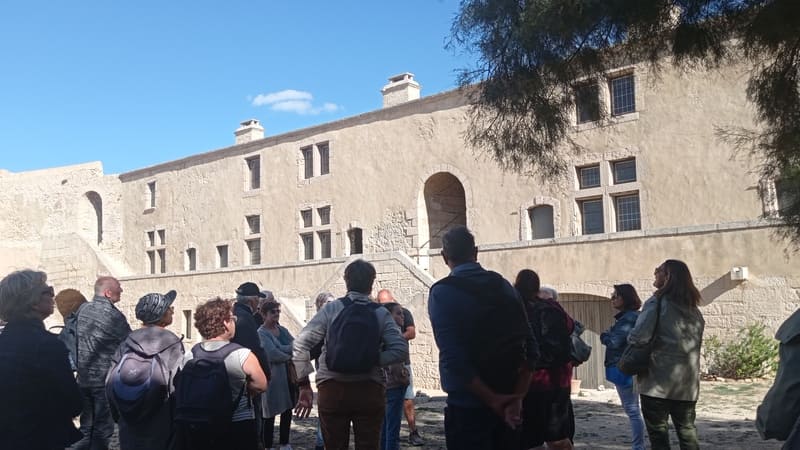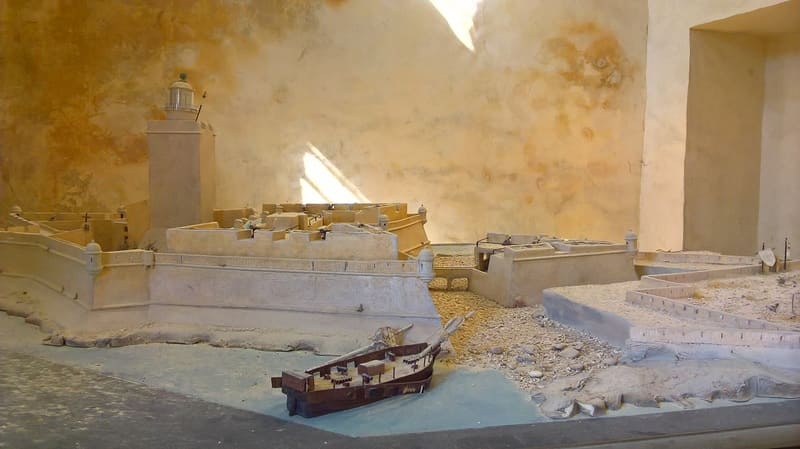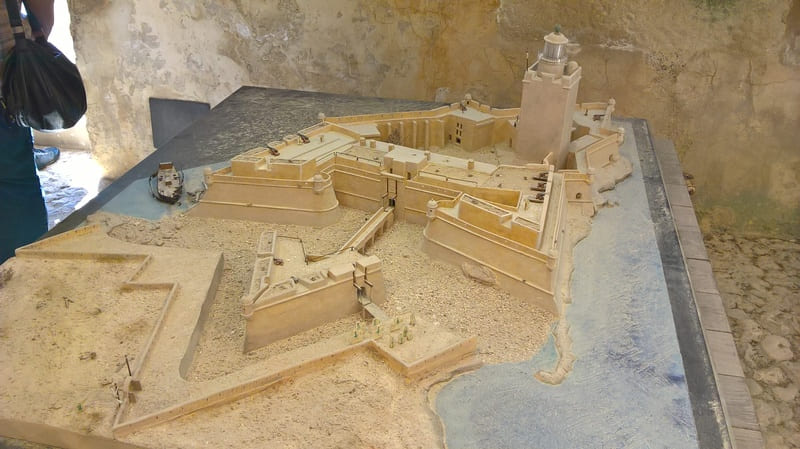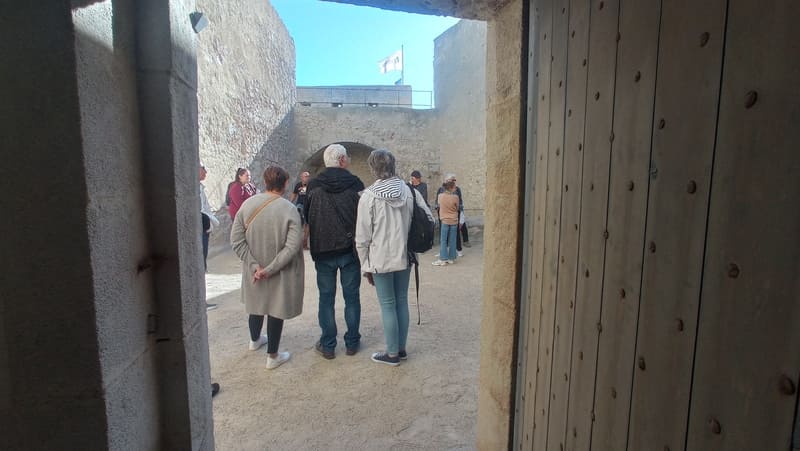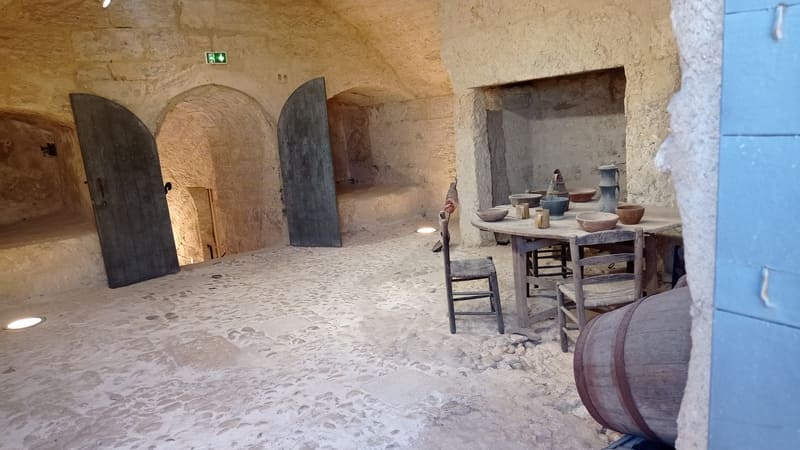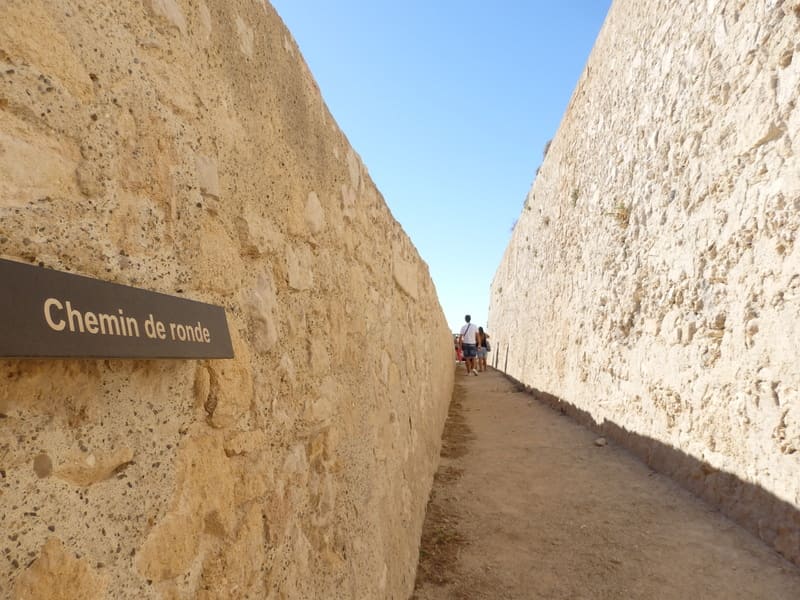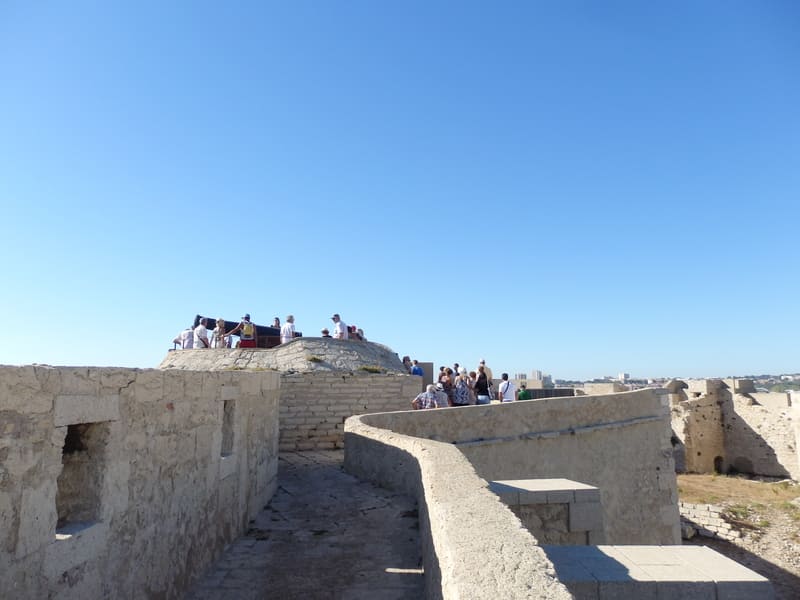History of Fort de Bouc
"Bouc" comes from Provençal meaning "mouth".
The Fort de Bouc is located more precisely at the mouth of the Caronte canal which connects the Mediterranean Sea to the Etang de Berre. It is accessed by boat, access being regulated.
The Fort de Bouc is located more precisely at the mouth of the Caronte canal which connects the Mediterranean Sea to the Etang de Berre. It is accessed by boat, access being regulated.
Crossing
Our visit begins at the port of the Martigues Tourist Office in the company of Justine, our guide for the day. The crossing (6km, 30 minutes) will quickly make us understand that Martigues is a city set on water, with two paradoxical faces of the 17th and 20th centuries.
The departure is in front of the Ile district, a real island inhabited since prehistoric times and consolidated by stones from La Couronne in antiquity by the Gauls.
Justine tells us the story of Martigues during the crossing
In the Middle Ages, Martigues included several sèdes - these parallel tongues of land in the direction of the channel formed by currents and arranged by men - which were used to set up the bourdigues, these ingenious fishing systems designed as fish traps built in reed hurdles.
Our trip therefore takes us near Calen, one of the last in France and still active in Martigues. On the same site for a century, it ensures the sustainability of one of its renowned culinary traditions: bottarga (dried muge eggs used as an aperitif or as an accompaniment to pasta).
In the distance, the railway viaduct looms, the first sign of 20th century modernity.
Built in 1908, it will engage the territory towards oil projects from the 1920s.
In the distance, the railway viaduct looms, the first sign of 20th century modernity.
Built in 1908, it will engage the territory towards oil projects from the 1920s.
Everything is surprising in this part!
The long quay on our right houses an old factory where oil and soap were produced in 1923. The Verminck factory very quickly became the city's largest employer with a very diverse workforce in terms of geographic origin. It closed in 1985.
Finally, the Fort de Bouc stands in front of us perching on its island (L'Ile de Bouc), an unassailable rock, surmounted by a medieval square tower.
Finally, the Fort de Bouc stands in front of us perching on its island (L'Ile de Bouc), an unassailable rock, surmounted by a medieval square tower.
The military fort remained almost half a century in its isolation, abandoned facing the sea while awaiting a burst of history. This still little known monument is one of the rare bastioned fortifications from the 17th century that has remained practically intact until today.
We dismount.
We dismount.
A visit over the centuries
You enter Fort de Bouc via a half-moon which aims to protect the curtain wall, the most fragile element of the fort.
A ditch is carved into the rock which is probably partly submerged when the sea is high.
We follow our guide and cross it by a fixed bridge and a lifting bridge.
Above our heads, an eroded coat of arms announces the color.
On the bridge, we take the opportunity to have a global vision of the fort. We learn that it belonged to the lords of Fos in the 11th century.
It will then experience several architectural evolutions over the centuries.
We enter the Fort to find ourselves in a vaulted passage. Above the vault, the room of the guards is there. It was used as a stunner (the soldiers threw pebbles or boiling lime into it to defend themselves).
Justine tells us that an organ system was used to secure the drawbridge; and not a system of harrows in accordance with traditional forts. You can also see firing embrasures (corners that correspond with the casemate). This passage is the only possible access to the Place d'Armes.
We access the central courtyard and find ourselves at the foot of the massive square tower that we can see when we arrive by boat.
The change of scenery is total, it's a dive into history
This courtyard was left empty and notably favored the gathering of troops; the fort accommodated 60 people in peacetime (against 150 in war).
The Stone Goat Tower as we see it dates from the 15th century. We recognize a resemblance to that of Fort Saint-Jean, built by King René (1443/1447). Almost square (24x11x12), it has a single access by a ladder to the 1st floor.
The square tower is in the center of the fort like a keep of medieval castles.
In the 11th century, it made it possible to control the ships entering the pond and possibly protect themselves from the looting of Mediterranean pirates. The pink stone which constitutes it is extracted since antiquity from the quarries which border the coast in the region of Martigues, La Couronne.
It was subsequently intended to be used as a lighthouse. It made it possible to communicate step by step by towers thanks to the lighting of fires.
This was particularly effective in warning the population of the arrival of an enemy ship. The tower has withstood everything for centuries, even the Germans.
The Stone Goat Tower as we see it dates from the 15th century. We recognize a resemblance to that of Fort Saint-Jean, built by King René (1443/1447). Almost square (24x11x12), it has a single access by a ladder to the 1st floor.
The square tower is in the center of the fort like a keep of medieval castles.
In the 11th century, it made it possible to control the ships entering the pond and possibly protect themselves from the looting of Mediterranean pirates. The pink stone which constitutes it is extracted since antiquity from the quarries which border the coast in the region of Martigues, La Couronne.
It was subsequently intended to be used as a lighthouse. It made it possible to communicate step by step by towers thanks to the lighting of fires.
This was particularly effective in warning the population of the arrival of an enemy ship. The tower has withstood everything for centuries, even the Germans.
Justine explains that the fort has been passed from hand to hand, and has undergone changes over time.
A little history
While the fort had been ceded to the Marseillais in exchange for non-attack, they will be driven out towards the beginning of the 13th century. On the death of the last count of Provence in 1481 (Charles d'Anjou), the King of France (Louis XI) took the opportunity to claim the lands of Provence, including the Fort de Bouc.
In the 17th century, the fort became a state prison where political prisoners were locked up.
It welcomed Laurent de Colloris (president of the parliament of Aix), imprisoned for having revolted against Richelieu but also for having supported Gaston d'Orléans. This was also the case of Prince Casimir (King of Poland) for espionage.
Later, Vauban was commissioned by Louis XIV to improve the defenses of Fort de Bouc by adding ramparts whose shape made it possible not to be surprised during an attack because there was no blind spot. We also owe Vauban the development of new "comforts": accommodation for officers, a chapel and a sacristy as well as the transformation of a store into a canteen. We also owe him the development of a barracks and two casemates (fortified rooms).
It is precisely our next meeting place during the visit.
We access the first room in which is a historical model of Fort de Bouc.
This model represents the fort as it was in the middle of the 18th century and allows us to become aware of the architectural and functional evolution of the fort over time.
This model represents the fort as it was in the middle of the 18th century and allows us to become aware of the architectural and functional evolution of the fort over time.
Along the way, we note the presence of two galleries used for the dry storage of gun carriages.
We then access the "Corps de Garde" room, a real reconstruction of daily life.
Stunner, organ, bed, fireplace and food ... it's all there.
We then access the "Corps de Garde" room, a real reconstruction of daily life.
Stunner, organ, bed, fireplace and food ... it's all there.
The part of the visit that we preferred was the walk on the ramparts. Called "Chemin de Ronde", it is accessible along the entire length and allows you to contemplate remains from all eras. Loopholes exist all along the way, we are tempted to take a look.
The view at the top of the fort is breathtaking!
We join Justine who enumerates us the work carried out in 1935 by the French army and the installation of new concrete firing points.
In 1943, German troops occupied the fort and completed this device with two new anti-aircraft batteries, two Hotchkiss machine guns and small close defense structures. When disembarking, they will detonate the ammunition stored in the fort destroying part of the western bastion.
We find ourselves around a 36 pound cannon. These are 18th century relics, only two are original located on the South Cavalier and the West Bastion.
This cannon offered by the navy (Toulon base) armed the largest French vessels and coastal batteries from the 17th to the 19th centuries.
These canons perpetuate in memory, the project envisaged by Napoleon 1st.
In charge of the military buildings on the coast, he visited the Fort in 1973. He then dreamed of a major project for this fort and for Port-de-Bouc: the construction of a large military port. Ultimately, he will choose La Spezia.
The view at the top of the fort is breathtaking!
We join Justine who enumerates us the work carried out in 1935 by the French army and the installation of new concrete firing points.
In 1943, German troops occupied the fort and completed this device with two new anti-aircraft batteries, two Hotchkiss machine guns and small close defense structures. When disembarking, they will detonate the ammunition stored in the fort destroying part of the western bastion.
We find ourselves around a 36 pound cannon. These are 18th century relics, only two are original located on the South Cavalier and the West Bastion.
This cannon offered by the navy (Toulon base) armed the largest French vessels and coastal batteries from the 17th to the 19th centuries.
These canons perpetuate in memory, the project envisaged by Napoleon 1st.
In charge of the military buildings on the coast, he visited the Fort in 1973. He then dreamed of a major project for this fort and for Port-de-Bouc: the construction of a large military port. Ultimately, he will choose La Spezia.
From the middle of the 19th century, the maritime canal was dug as far as Martigues and the Étang de Berre (with 3 meters of draft increased to 6 meters 10 years later).
Port de Bouc was officially born on September 2, 1866 and will develop around shipyards. The city has taken the place of the factories which for nearly a century occupied precisely the framework drawn by Napoleon's engineers.
The Fort-de-Bouc is a mixture of medieval and modern which makes it a rare and atypical building.
The Martigues Tourist Office occasionally offers tours of Fort de Bouc.
Our reception agents remain available to inform you of the next visit.
Some numbers :
• 1592 to 1633: Major works (from 1601 by the engineers Bonnefon et fils)
• 1640 to 1651: Extensions of the fortifications
• 1686: Visit of Vauban
• 1690 to 1707: "Comfort" works under the reign of Louis XIV
• Before 1743: Construction of the chapel
• 1745: Construction of a lighthouse at the top of the tower
• 1856 to 1861: Installation of new gun batteries
• 1880: The fort takes the name of "Fort Suffren"
• 1889: Military decommissioning
• 1919: The fort is handed over to the navy
• 1930: Registration of the site on the list of Historic Monuments
• 1935 to 1943: Works by the French army
• 1942: Occupation by the German army
• 1993: Acquisition of Fort de Bouc by the city of Martigues
• 1999: Beginning of the restoration
• 2006: Obtaining the national prize "Les Rubans du Patrimoine"
• 2007: Open to the public
Port de Bouc was officially born on September 2, 1866 and will develop around shipyards. The city has taken the place of the factories which for nearly a century occupied precisely the framework drawn by Napoleon's engineers.
The Fort-de-Bouc is a mixture of medieval and modern which makes it a rare and atypical building.
The Martigues Tourist Office occasionally offers tours of Fort de Bouc.
Our reception agents remain available to inform you of the next visit.
Some numbers :
• 1592 to 1633: Major works (from 1601 by the engineers Bonnefon et fils)
• 1640 to 1651: Extensions of the fortifications
• 1686: Visit of Vauban
• 1690 to 1707: "Comfort" works under the reign of Louis XIV
• Before 1743: Construction of the chapel
• 1745: Construction of a lighthouse at the top of the tower
• 1856 to 1861: Installation of new gun batteries
• 1880: The fort takes the name of "Fort Suffren"
• 1889: Military decommissioning
• 1919: The fort is handed over to the navy
• 1930: Registration of the site on the list of Historic Monuments
• 1935 to 1943: Works by the French army
• 1942: Occupation by the German army
• 1993: Acquisition of Fort de Bouc by the city of Martigues
• 1999: Beginning of the restoration
• 2006: Obtaining the national prize "Les Rubans du Patrimoine"
• 2007: Open to the public



